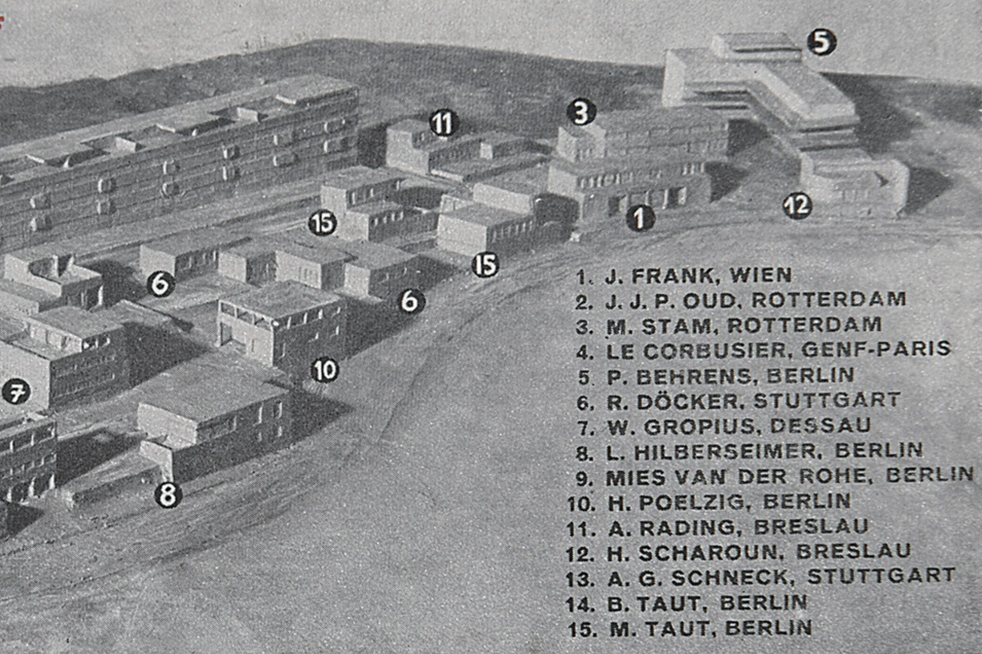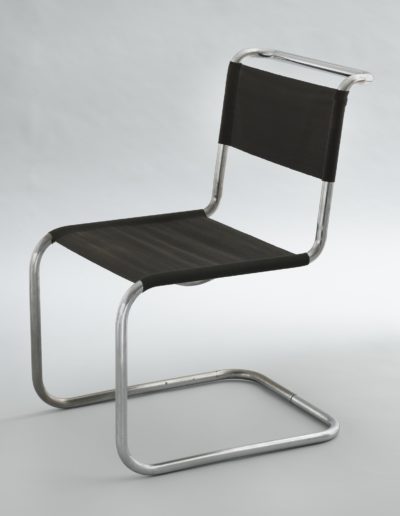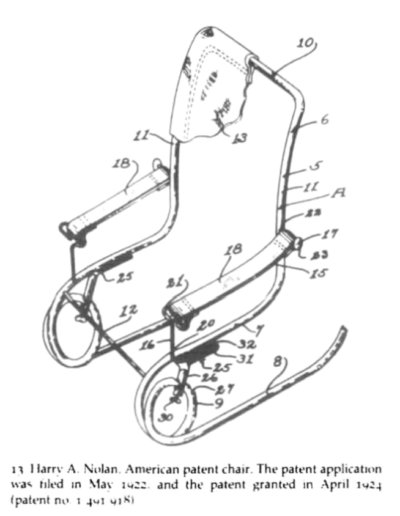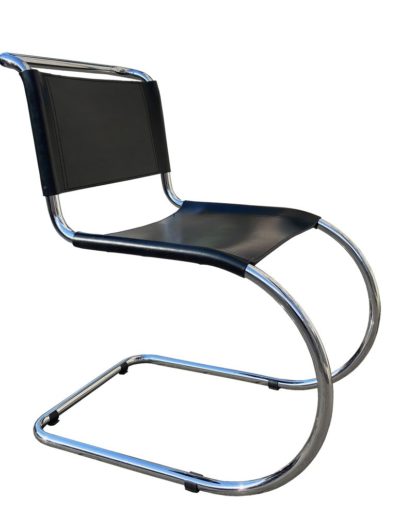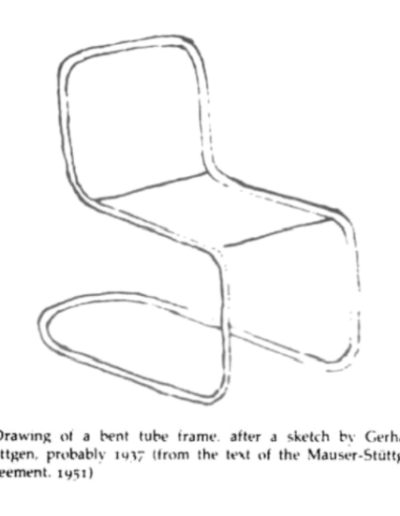The Contentious History of the Cantilever Chair?
This issue we were going to do a pretty straight forward overview of the life and works of Ludwig Mies Van der Rohe beginning with how he got his start as an apprentice stonemason at his father’s business, then furniture design with Bruno Paul in Berlin before working for Peter Behrens as an architect where his co-workers included Le Corbusier and Walter Gropius. After establishing his own office in Berlin and having the winning design for the German Pavilion at Barcelona Industrial Exposition, we were going to trace his successes and designs through his time at the Bauhaus and ultimately how his work literally changed the landscape of the United States with his minimalist skyscrapers and experimental homes – from Seagram building in New York to Farnsworth House in Plano, Illinois. We were going to feature his chair designs, mention the typeface he created and then conclude that he is considered one of the pioneers of modern architecture and his furniture designs are iconic.
However, as we started researching more and more about his chair designs we uncovered some far more interesting material. It turns out the history of the cantilever chair is a little murky and the dynamics of collaboration, fraught. So as best we can we will provide a brief history of events that includes Mies’ MR chairs.
What is fascinating is that almost 100 years later these chairs are still being produced, still highly sought after and still resonate with people today.
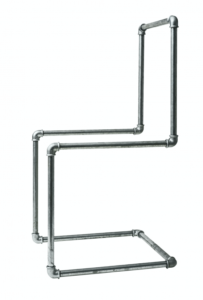 Let’s start with Mart Stam and the scribbled design on the back of a wedding invitation given to him by Will Baumesiter. As the story goes, there was a dinner at Hotel Marquardt in Stuttgart on 22nd November 1926 between organizers of the Die Wohnung exhibition and the Neues Bauen architects to discuss the design of Weissenhof Housing Estate in Stuttgart. It was an exhibition supervised by the then vice president of Deutscher Werkbund, Ludwig Mies van der Rohe and built in 1927. Sixteen architects were invited to submit original designs to furnish the proposed homes. At this dinner Mart Stam sketched out a design for a metal tubular cantilever chair in blue pencil that he intended to create for his pregnant wife. According to fellow architect Ferdinand Kramer, Stam’s idea came from the cantilever flat steel-framed folding seat found in the 1926 Tatra T12 two-door saloon car. Mies was at that dinner. And here is where the stories diverge.
Let’s start with Mart Stam and the scribbled design on the back of a wedding invitation given to him by Will Baumesiter. As the story goes, there was a dinner at Hotel Marquardt in Stuttgart on 22nd November 1926 between organizers of the Die Wohnung exhibition and the Neues Bauen architects to discuss the design of Weissenhof Housing Estate in Stuttgart. It was an exhibition supervised by the then vice president of Deutscher Werkbund, Ludwig Mies van der Rohe and built in 1927. Sixteen architects were invited to submit original designs to furnish the proposed homes. At this dinner Mart Stam sketched out a design for a metal tubular cantilever chair in blue pencil that he intended to create for his pregnant wife. According to fellow architect Ferdinand Kramer, Stam’s idea came from the cantilever flat steel-framed folding seat found in the 1926 Tatra T12 two-door saloon car. Mies was at that dinner. And here is where the stories diverge.
One version of events states that Mies mentioned Stam’s chair design to Marcel Breuer at the Bauhaus which led them both to immediately create variations of Stam’s design. Breuer claims instead that he and Stam had an in-depth, one on one discussion on a train from Frankfurt to Stuttgart. Breuer claims to have been naive and shared everything about his chair designs. The outcome being that Stam stole Breuer’s ideas which were inspired by the Thonet bentwood chairs and the handlebars of his Adler bicycle he rode to the Bauhaus. Through two subsequent court cases it was uncovered that in 1923/1924 Gerhard Stuttgen, a Cologne metal worker, exhibited a metal chair frame without back legs. With the addition of a wooden board, one could sit on it but no one including Stuttgen valued the invention and the tube frame was discarded in 1926.
Art Historians who, in 1975, were challenged by the lack of attribution for the cantilever chairs, turned to these court case documents for clarity.
Breuer and Stam Chairs
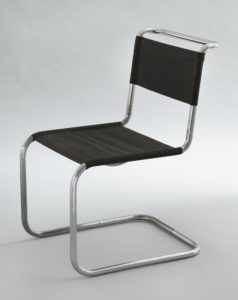 Marcel Breuer and Kalman Lengyel established Standard-Mobel Lengyel & Co. at the end of 1926. Shortly after in 1927, Anton Lorenz, a businessman was brought into the fold. Breuer left the firm in July 1928 transferring the right to all his tubular design to the company. He was already working on new designs which he did not transfer. At the same time he entered an agreement with Thonet and production started in 1929. There was a point where both Standard-Mobel and Thonet were producing Breuer’s chairs models named L33, L34 and B33, B34 respectively. Thonet bought Standard-Mobel in 1929 but Lorenz did not include the rights to the L33 and L34. L34 included armrests that Lorenz had a patent on and he signed a contract with Mart Stam for the rights to L33. Thonet considered the chairs Breuer designs and in purchasing Standard-Mobel believed the rights were conferred to them. Lorenz established DESTA later that same year and manufactured L33 and L34.
Lengthy court battles in Berlin ensued and at the core was the question: Was Stam’s chair a work of arts and craft or a technical innovation? Only a work of arts and craft could obtain copyright protection. Thonet argued that the form of the chair was technical innovation and in turn not protected. The judge disagreed – it was the minimalist, sparse form embodying modernism as its objective that made it a work of art regardless of the qualities of the materials chosen. Thonet also referenced Harry A. Nolan’s 1922 cantilever chair was deemed “cluttered pomposity” and Mies Van Der Rohe’s was rejected since its movements were similar to the Nolan chair. Thonet tried a lot of different strategies even arguing for the quality of its own model which was dismissed by the court stating that differences in materials used are technical. Artistically the chairs closely resemble each other and essential features don’t differentiate them. Walter Gropius was commissioned by Thonet to provide a report which essentially stated that Stam imitated Breuer’s design which in itself was a development of a B5 model chair that used the same materials but not cantilever. The court disagreed. Thonet models were considered replicas.
In the end, the rights were assigned to Lorenz and DESTA had the sole rights for cantilever chairs and Thonet could only produce such chairs under licence. One month after winning, Lorenz made an agreement with Thonet giving them the rights. The outcome was from 1933 onwards, Thonet had to give attribution to Stam and Lorenz even though they didn’t design the chairs, Breuer did.
Marcel Breuer and Kalman Lengyel established Standard-Mobel Lengyel & Co. at the end of 1926. Shortly after in 1927, Anton Lorenz, a businessman was brought into the fold. Breuer left the firm in July 1928 transferring the right to all his tubular design to the company. He was already working on new designs which he did not transfer. At the same time he entered an agreement with Thonet and production started in 1929. There was a point where both Standard-Mobel and Thonet were producing Breuer’s chairs models named L33, L34 and B33, B34 respectively. Thonet bought Standard-Mobel in 1929 but Lorenz did not include the rights to the L33 and L34. L34 included armrests that Lorenz had a patent on and he signed a contract with Mart Stam for the rights to L33. Thonet considered the chairs Breuer designs and in purchasing Standard-Mobel believed the rights were conferred to them. Lorenz established DESTA later that same year and manufactured L33 and L34.
Lengthy court battles in Berlin ensued and at the core was the question: Was Stam’s chair a work of arts and craft or a technical innovation? Only a work of arts and craft could obtain copyright protection. Thonet argued that the form of the chair was technical innovation and in turn not protected. The judge disagreed – it was the minimalist, sparse form embodying modernism as its objective that made it a work of art regardless of the qualities of the materials chosen. Thonet also referenced Harry A. Nolan’s 1922 cantilever chair was deemed “cluttered pomposity” and Mies Van Der Rohe’s was rejected since its movements were similar to the Nolan chair. Thonet tried a lot of different strategies even arguing for the quality of its own model which was dismissed by the court stating that differences in materials used are technical. Artistically the chairs closely resemble each other and essential features don’t differentiate them. Walter Gropius was commissioned by Thonet to provide a report which essentially stated that Stam imitated Breuer’s design which in itself was a development of a B5 model chair that used the same materials but not cantilever. The court disagreed. Thonet models were considered replicas.
In the end, the rights were assigned to Lorenz and DESTA had the sole rights for cantilever chairs and Thonet could only produce such chairs under licence. One month after winning, Lorenz made an agreement with Thonet giving them the rights. The outcome was from 1933 onwards, Thonet had to give attribution to Stam and Lorenz even though they didn’t design the chairs, Breuer did.Mies Van der Rohe
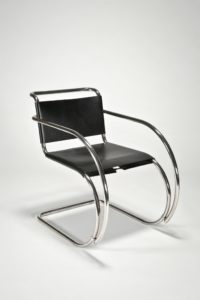 Mies filed for a patent 3 days before exhibiting his, now classic MR chairs at the Werkbund Stuttgart. The process to secure a patent based on technical principle took Mies 3 years to secure and required novel presentations including reproducing Harry A. Nolan’s 1924 chair which the patent officer proceeded to sit in and fall backwards. Mies successfully argued that the bent steel tubing, sufficient spring (resilience) and the form (a seat frame and support made of a single piece of resilient steel tube bent in a semicircle and forms a continuous line) were technical features of his chairs.
With his patent secured, Mies and his lawyer approached manufacturers L & C Arnold and Mauser for violations. In response, they sued Mies to void his patent. Mauser argued for the differences in formal values and there were already multiple examples of the similar technology at the time of the patent registration. The Mauser chair models Mies took action against do not resemble his chairs however he successfully argued that they were made of the same materials as his own and were resilient therefore coming under the protection of his patent. Even though his patent describes a semi-circle and no back legs, even the Mauser chair with no front legs was found to be in violation. The court deciding that no back legs was not an essential sign of the invention and that general characteristics were the decisive factor.
Mauser’s evidence included Stam’s chair as proof of contemporary designs similar to Mies’. It was rejected on the basis that steel liner was added to stiffen the steel tubing and therefore lacked resilience. Mies had Stam’s chair measured as part of the patent process and produced proof. In addition the patent was lodged 3 days before the opening of the Werkbund exhibition where Stam’s chairs were on public display for the first time and was therefore rejected as a pre-existing model. Mauser in the last months before final judgment acquired the rights to Gerald Stuttgen’s design. This too failed to impress the court as Stuttgen admitted that in bending the steel form in 1924 and placing a board on it, it was a chance result and not by intention. In the end Mauser’s claims were rejected and Mies retained his patent.
Mies filed for a patent 3 days before exhibiting his, now classic MR chairs at the Werkbund Stuttgart. The process to secure a patent based on technical principle took Mies 3 years to secure and required novel presentations including reproducing Harry A. Nolan’s 1924 chair which the patent officer proceeded to sit in and fall backwards. Mies successfully argued that the bent steel tubing, sufficient spring (resilience) and the form (a seat frame and support made of a single piece of resilient steel tube bent in a semicircle and forms a continuous line) were technical features of his chairs.
With his patent secured, Mies and his lawyer approached manufacturers L & C Arnold and Mauser for violations. In response, they sued Mies to void his patent. Mauser argued for the differences in formal values and there were already multiple examples of the similar technology at the time of the patent registration. The Mauser chair models Mies took action against do not resemble his chairs however he successfully argued that they were made of the same materials as his own and were resilient therefore coming under the protection of his patent. Even though his patent describes a semi-circle and no back legs, even the Mauser chair with no front legs was found to be in violation. The court deciding that no back legs was not an essential sign of the invention and that general characteristics were the decisive factor.
Mauser’s evidence included Stam’s chair as proof of contemporary designs similar to Mies’. It was rejected on the basis that steel liner was added to stiffen the steel tubing and therefore lacked resilience. Mies had Stam’s chair measured as part of the patent process and produced proof. In addition the patent was lodged 3 days before the opening of the Werkbund exhibition where Stam’s chairs were on public display for the first time and was therefore rejected as a pre-existing model. Mauser in the last months before final judgment acquired the rights to Gerald Stuttgen’s design. This too failed to impress the court as Stuttgen admitted that in bending the steel form in 1924 and placing a board on it, it was a chance result and not by intention. In the end Mauser’s claims were rejected and Mies retained his patent. Judicial and historical accounts differ and we will likely never know what really happened. Historians tend to support Stam as the inventor of the cantilever chair. What is fascinating is that almost 100 years later these chairs are still being produced, still highly sought after and still resonate with people today. Perhaps their enduring popularity is the real resilience and art and craft of these chairs.
